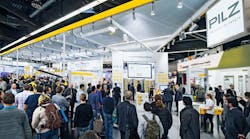When we caught up with Thomas Pilz, the engaging managing director of the automation safety firm Pilz at the recent Hannover Messe trade fair, his company’s booth was in a sea of firms offering products and services for the manufacturing transformation known in Germany as Industrie 4.0 or more commonly here in the United States as the Industrial Internet of Things.
Pilz told IndustryWeek the stakes are high for Western countries that have watched manufacturing migrate to countries such as China and Vietnam where labor rates are much lower than in the U.S. or Germany. He likened the change needed to when the United States developed the Marshall Plan after World War II and helped Germany invest in the latest manufacturing technology.
“We have an installed base and old plants,” says Pilz. “If we don’t invest in Industrie 4.0 technology, we run the risk of being overtaken by countries like China that don’t have this old industry to protect.”
Few companies at the trade fair were better prepared for this technological revolution than Pilz, a family-owned firm based in Stuttgart, Germany with more than 2,000 employees. Thomas Pilz’ sister worked with German authorities to develop the initial concept of Industrie 4.0, which is described as when “people, machines, equipment, logistics systems and products communicate and cooperate with each other directly. Production and logistics processes are integrated intelligently across company boundaries to make manufacturing more efficient and flexible.”
Pilz added that the belief that new technology is needed to compensate for high wages extends beyond the U.S. and Western Europe.
“You really can’t say what are high labor costs,” says Pilz. “China feels they have high labor costs. All of us can only laugh about that but they think it is way too expensive to manufacture in China and so they need to automate with robots. And because China is faced with Industrie 4.0, it is very possible that those technologies will grow fastest in China.”
While Pilz advocates that companies invest in the new technologies, he and his general manager in the United States, Mike Beerman, both say many customers are still taking a wait and see attitude toward the new technology. Beerman likens this caution to when Pilz introduced a variety of machine safety products to the U.S. market 20 years ago.
Find the Latest Internet-of-Things News, Trends and Best Practices
“They want to make sure that this isn’t a fad, that it isn’t going to go away,” Beerman observes. “They want to make sure that this actually makes good business sense. Over the course of time, they will be convinced, just as they were with safety. It will take a little more time in the United States… Europe got a little bit of a head start on us.”
Pilz advises that manufacturers make sure they introduce the new technology so that their workforces are comfortable with the change.
“Look at your people first,” Pilz advised. “You can only implement technology that the people that work with you can actually handle. Give them a chance to grow with it. Try smalls steps. Everyone who has walked in and said this is the big picture concept and I am going to implement it in one big step fails.”
Safety for the Evolving Factory
As the technology in factories shifts, Pilz is introducing automation safety products to meet their flexibility and communications requirements. For example, Pilz offers a SafetyEye camera system that combines with sensors to provide easily reconfigurable 3D protection zones. Zones can be set up that offer a warning first and then shut off machinery when the protection zone is entered. Pilz said this product offers the “active guarding” that allows for human-robot collaboration.
Pilz got a jump on the factory modularity trend, says Thomas Pilz, with the introduction of its PSS 4000 automation system in 2009. He noted that the system can be used independent of Pilz hardware and is offered on a “pay as you use” basis. “We are the first to offer our customers software functionality to be paid for as it is used,” he says.
Industrie 4.0 won’t be just a matter of reconfiguring plant machinery and introducing new processes. Pilz expects it to have a profound impact on how plants are operated. For example, he said that managers in a plant who do scheduling will not be needed in the future when each device being manufactured has a sensor and the plant can actually schedule itself automatically.
“We already have high automated plants in the United States and Germany,” notes Pilz. “You won’t lose jobs on the shop floor. You definitely will lose jobs in the management area.”
Like any other transformation, it will take time for manufacturers to become comfortable with the changes brought by the industrial internet. One of the biggest concerns, of course, is security. Pilz noted that as factories become connected to the internet, they run the risks familiar to anyone who is active on the internet can encounter, such as malicious viruses. But they also may encounter new risks that connected technology introduces, such as piracy. Pilz offered the example of a two chocolate manufacturers heading into the Christmas season.
“What if one competitor decides to attack the scheduling system and change the amount of sugar for the chocolate?” Pilz poses. “Then you only get bitter chocolate from this manufacturer and the other who has the sweet chocolate takes over the market.”
“The value of the things that you produce become less about the actual device and more about the data sets that you use to produce the device,” notes Beerman. “That is why the ability to protect that data set becomes so important.”
Attendees watched at the Pilz booth as a demonstration system produced metal cases for business card engraved with their names and a QR code. It was a small taste of the manufacturing revolution coming.
“We feel the need for customized products at the cost of mass market products will help drive the Internet of Things and Industrie 4.0 technology,” said Pilz. “When it is demonstrated that you can bring back jobs from the low-cost countries into our industrial environment, whether it be the U.S. or Germany, then people will buy into the technology. If we can’t prove that, then it’s just another gimmick that no one will invest in.”




